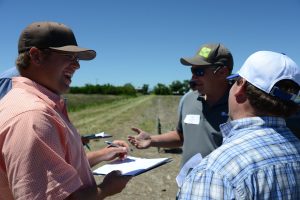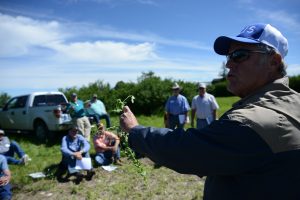Evan Volf spent a few years in banking after college. He had a good job with Northwest Farm Credit Services managing a growing portfolio in Bozeman.

It was 9-5 with weekends off, retirement and health insurance. The money was great for his growing family.
But Volf’s heart was at the family ranch and farm 120 miles north in Judith Gap. He grew up there with his two brothers and always dreamed of going back to work the land with his father, Jeff.
When his dad called one day and said there was a chance to lease more land and grow the business, he gladly gave up his banking job and moved his family back to the farm.

It certainly wasn’t the low pay or working seven days a week at the mercy of weather that brought him back.
“What brought us back is the lure of the country lifestyle and being your own boss and working with your family,” he said. “And working with your kids on a day-to-day basis and bringing them up with the values that we all know and love.”
The story of the Volf family is among several that National Crop Insurance Services documented in Montana as part of its ongoing series on American farmers and ranchers. The state’s vast distances and often unpredictable weather make farming and ranching here challenging.
Today, Evan farms with his wife, Brittany, three children EJ, Miles and Dexter, and his mom and dad. They raise red angus cattle, wheat, barley, alfalfa along with willow creek hay barely and peas.
This year, bad weather delayed planting. Typically, they are seeding by April 20, but weren’t able to get a seed in the ground until May 5.
And a big storm two days later brought five more inches of snow and kept them out of the fields for another two weeks.
His father, also grew up on the farm and ranch and has been running it full-time since 1978. He’s seen plenty of springs like this last one.
“Mother nature is always in the background saying hey we are going to dry out here next week … so we just really need to have (crop insurance) to cover our expenses if we do have major wipe out here with hail or a drought. And we’ve had that,” Jeff said.
Evan is likewise glad that crop insurance is part of the family’s business plan.
“Thankfully, we have crop insurance to help us manage these kinds of circumstances. We pay for this protection, but it is well worth it,” he explained.
Not far from the Volf farm, insurance adjusters learned how to accurately assess damage to crops in a training session at Montana State University’s Central Ag Research Center in Moccasin.

Eddy Joyce, an adjuster with ARMTech Insurance, who currently serves as the chair of the NCIS Montana Committee, was one of the instructors.
“We provide schools for both new and experienced adjusters and we also discuss potential policy issues within the crops here in Montana,” Joyce said.
Joyce said having a training school is important to make sure everyone is on the same page and to get all the adjusters, both young and old – experienced and inexperienced – familiar with the policies so there’s no variability.
“Any time you can be prepared and educated, I believe in any field, you are going to put whoever you are working with at ease. If they can see you are a knowledgeable individual within your field and a professional within your field they are going to be a lot more comfortable with you than if you go in blind, so to say,” Joyce said.
Mike Mills, who works for Rural Community Insurance Services and served as a trainer at the school, agreed.

“It’s really important that adjusters are trained in the NCIS procedures for the crops that have been researched so very well by the different aggregate universities throughout the Northwest and Montana and some even in southern Canada. They give us the most viable and accurate and fair way of providing, adjusting and evaluating crop damage to give the farmers fair payments on the policies they have bought,” Mills said.
Watch these stories and more at cropinsuranceinmystate.org

